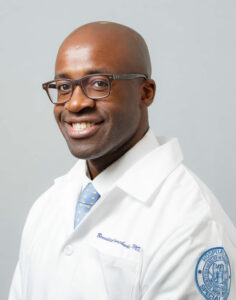Shoulder Instability Surgeon

Are you an athlete who participates in a sport that involve repetitive overhead motions? If so, you may be at risk of developing shoulder instability which requires surgical repair. Arthroscopic shoulder surgeon, Doctor Benedict Nwachukwu provides diagnosis as well as arthroscopic stabilization surgery for patients in Manhattan, New York City, NY who are experiencing shoulder instability. Contact Dr. Nwachukwu’s team today!
What causes shoulder instability?
The shoulder is one of the most complex joints in the human body. Formed by the humerus (upper arm bone) fitting snugly into the scapula (shoulder blade) this ball and socket joint allows for a wide range of motion. Ligaments, tendons and the labrum are supportive soft tissues within the shoulder, keeping the ball and joint together, giving it strength and stability. Shoulder instability occurs when the soft tissues of the shoulder become injured or weak. If the humerus and the scapula are forced out of their anatomical position and away from each other, either from a sports tackle, falling or lifting something heavy overhead; a shoulder dislocation can occur. During a shoulder dislocation the soft tissues become damaged and can stretch or tear away from their position in the shoulder. A shoulder dislocation can cause shoulder instability and weakness. If the shoulder has been out of joint, it is very likely to slip out of socket again. Severe cases of shoulder instability can benefit from arthroscopic stabilization for shoulder instability. For patients in Manhattan, New York City and the surrounding New York boroughs, Dr. Benedict Nwachukwu can perform this specialized procedure, and help return full function to the affected shoulder.
What is arthroscopic stabilization for shoulder instability?
Arthroscopic stabilization for shoulder instability is a minimally invasive shoulder treatment used to tighten and repair soft tissue damage within the shoulder. During this surgical procedure, Dr. Nwachukwu uses specialized equipment to inspect and repair the damaged areas in the shoulder joint. He uses suture anchors to reattach loose or torn ligaments to the glenoid bone. These sutures will restore the joint’s anatomy to its normal position and “tighten” the shoulder joint and keep it in its normal place.
For patients who experience bone loss, long-standing shoulder instability or a shoulder dislocation that cannot be put back into place, open surgery may be recommended over shoulder arthroscopy. During open surgery, a slightly larger incision is used, allowing Dr. Nwachukwu to better visualize the entire joint while making the necessary repairs.
What is a capsular shift?
A capsular shift is the name of a procedure used to tighten the joint capsule. During this open procedure, Dr. Nwachukwu tightens the soft tissues of the joint, including the ligaments that stabilize the shoulder. This is done in a similar way that a tailor tucks in loose fabric by overlapping and sewing the two parts together. The subscapularis muscle (part of the rotator cuff) is carefully incised, allowing Dr. Nwachukwu to visualize the shoulder capsule. The capsule is then split, with one part pulled up and the other pulled down, decreasing the volume of the shoulder joint. The capsular shift is a proven method for improving shoulder instability although the recovery can be longer, in part because of the open approach.
How long is the recovery after arthroscopic stabilization and shoulder instability surgery?
It is critical that the arm remains immobile after arthroscopic stabilization surgery, in a sling, for a period of time determined by Dr. Nwachukwu. Typically this will be 3 to 6 weeks. Pain medications and ice packs are recommended to help alleviate pain as the joint heals.
The rehabilitation protocol needs to be followed for the best possible outcome. Rehabilitation commonly consists of gentle passive range of motion exercises, followed by active motion. Physical therapy will include strengthening and eventually, a full return to activities in about 4-6 months with continued improvement for a year or two after surgery.
For additional resources about arthroscopic labral and SLAP tear surgery, or to have your shoulder pain or shoulder instability evaluated, please contact the office of Benedict Nwachukwu, MD, orthopedic shoulder surgeon serving Manhattan, New York City and surrounding New York boroughs.





